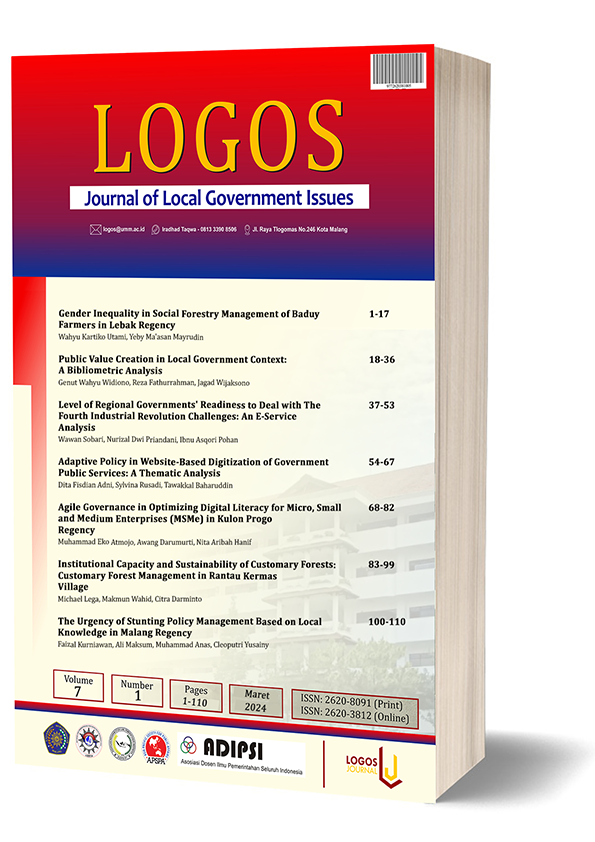Institutional Capacity and Sustainability of Customary Forests: Customary Forest Management in Rantau Kermas Village
DOI:
https://doi.org/10.22219/logos.v7i1.31717Keywords:
customary forests: forest managenent; forest sustainibility; instituitional capacityAbstract
The urgency of managing natural resources, especially customary forests, is increasing along with climate change and environmental degradation, which threaten the sustainability of the global ecosystem. This research aims to investigate the role of customary forest management in maintaining environmental sustainability and the welfare of local communities while identifying institutional capacity to achieve these goals. This research involves an in-depth case study of the Customary Forest Management Group (KPHA) in Rantau Kermas Village. Data sources were obtained through interviews, documentation and observation. This study also utilized the Nvivo 12 Plus analysis tool to assist with data coding. This research reveals that effective customary forest management can maintain a balanced ecosystem, protect biodiversity, and provide economic benefits to local communities. Strengthening institutional capacity through community participation, strong regulations, and collaboration with various related parties is the key to achieving this goal. This research implies the importance of supporting and developing sustainable customary forest management practices and strengthening institutional capacity to ensure environmental sustainability and the welfare of local communities in the future.
Downloads
References
Abatzoglou, J. T., Battisti, D. S., Williams, A. P., Hansen, W. D., Harvey, B. J., & Kolden, C. A. (2021). Projected increases in western US forest fire despite growing fuel constraints. Communications Earth and Environment, 2(1). https://doi.org/10.1038/s43247-021-00299-0
Alam, M. K. (2021). A systematic qualitative case study: questions, data collection, NVivo analysis and saturation. Qualitative Research in Organizations and Management: An International Journal, 16(1), 1–31. https://doi.org/10.1108/QROM-09-2019-1825
Austin, K. G., Mosnier, A., Pirker, J., McCallum, I., Fritz, S., & Kasibhatla, P. S. (2017). Shifting patterns of oil palm driven deforestation in Indonesia and implications for zero-deforestation commitments. Land Use Policy, 69, 41–48. https://doi.org/10.1016/j.landusepol.2017.08.036
Azwar, B., Roza, D., Thamrin, H., & Elfiandri, E. (2021). Strategi keberlanjutan pengelolaan hutan larangan adat Kenegerian Rumbio Kabupaten Kampar Propinsi Riau. Dinamika Lingkungan Indonesia, 8(1), 57. https://doi.org/10.31258/dli.8.1.p.57-64
Badan Pusat Statistik Provinsi Jambi. (2020). Luas Kawasan Hutan (Hektar), 2017-2019. https://doi.org/10.1055/s-2008-1040325
Buchari, A., Santoso, M. B., & Marlina, N. (2017). Jurnal Analisis dan Kebijakan Publik. Jurnal Analisis Dan Kebijakan Publik, 3(1), 49–62.
Budiman, I., Fujiwara, T., Harada, K., & Sato, N. (2021). Customary forest managements and its challenges in East Nusa Tenggara, Indonesia: An implication of constitutional court decision 2012. Jurnal Manajemen Hutan Tropika, 27(1), 69–79. https://doi.org/10.7226/jtfm.27.2.69
Campos, J. L. A., & Albuquerque, U. P. (2021). Indicators of conservation priorities for medicinal plants from seasonal dry forests of northeastern Brazil. Ecological Indicators, 121, 106993. https://doi.org/10.1016/j.ecolind.2020.106993
Chahyana, I., Hutomo, P., Hernawan, E., & Titisari, P. (2024). The role of indigenous people to the viability of traditional forest management: A case study from Imbo Putui Customary Forest. IOP Conference Series: Earth and Environmental Science, 1297(1), 012091. https://doi.org/10.1088/1755-1315/1297/1/012091
Domorenok, E., Graziano, P., & Polverari, L. (2021). Introduction: policy integration and institutional capacity: theoretical, conceptual and empirical challenges. Policy and Society, 40(1), 1–18. https://doi.org/10.1080/14494035.2021.1902058
Fatimah, A. S. (2019). Kapasitas Kelembagaan Dinas Pengendalian Penduduk, Keluarga Berencana, Pemberdayaan Perempuan Dan Perlindungan Anak Kota Tasikmalaya. Jurnal Administrasi Dan Kebijakan Publik, 4(1), 1–11. https://doi.org/10.25077/jakp.4.1.1-11.2019
Galudra, G., van Noordwijk, M., Agung, P., Suyanto, S., & Pradhan, U. (2014). Migrants, land markets and carbon emissions in Jambi, Indonesia: Land tenure change and the prospect of emission reduction. Mitigation and Adaptation Strategies for Global Change, 19(6), 715–731. https://doi.org/10.1007/s11027-013-9512-9
Ganguly, A., Talukdar, A., & Chatterjee, D. (2019). Evaluating the role of social capital, tacit knowledge sharing, knowledge quality and reciprocity in determining innovation capability of an organization. Journal of Knowledge Management, 23(6). https://doi.org/10.1108/JKM-03-2018-0190
Gasparinetti, P., Brandão, D. O., Maningo, E. V., Khan, A., Cabanillas, F., Farfan, J., Román-Dañobeytia, F., Bahri, A. D., Ponlork, D., Lentini, M., Alexandre, N., & Araújo, V. da S. (2022). Economic Feasibility of Tropical Forest Restoration Models Based on Non-Timber Forest Products in Brazil, Cambodia, Indonesia, and Peru. Forests, 13(11), 1878. https://doi.org/10.3390/f13111878
Ghorbanzadeh, O., Blaschke, T., Gholamnia, K., & Aryal, J. (2019). Forest fire susceptibility and risk mapping using social/infrastructural vulnerability and environmental variables. Fire, 2(3), 1–27. https://doi.org/10.3390/fire2030050
Gutierrez Garzon, A. R., Bettinger, P., Abrams, J., Siry, J. P., & Mei, B. (2022). Forest Sustainability in State Forest Management Plans: A Content Analysis. Journal of Sustainable Forestry, 41(1), 92–113. https://doi.org/10.1080/10549811.2021.1884575
Harada, K., Habib, M., Sakata, Y., & Maryudi, A. (2022). The role of NGOs in recognition and sustainable maintenance of customary forests within indigenous communities: The case of Kerinci, Indonesia. Land Use Policy, 113,105865. https://doi.org/10.1016/j.landusepol.2021.105865
Harlin, M. M., & Pinchot, G. B. (1974). Ecological Aquaculture. BioScience, 24, (9). https://doi.org/10.2307/1296879
Hayek MN, Harwatt H, Ripple WJ, & Mueller ND. (2020). The carbon opportunity cost of animal-sourced food production on land. Nature Sustainability, 10–13. https://ideas.repec.org/a/nat/natsus/v4y2021i1d10.1038_s41893-020-00603-4.html
Hidayat, D. C., Surati, Sylviani, Sakuntaladewi, N., Ariawan, K., & Ekawati, S. (2021). Customary Forest Utilization: The Determinants of Indigenous (Adat) Community’s Economic Welfare. IOP Conference Series: Earth and Environmental Science, 940(1), 12094. https://doi.org/10.1088/1755-1315/940/1/012094
Ibrahim, A. H. H., Baharuddin, T., & Wance, M. (2023). Developing a Forest City in a New Capital City: A Thematic Analysis of the Indonesian Government’s Plans. Jurnal Bina Praja, 15(1), 1–13. https://doi.org/ 10.21787/jbp.15.2023.1-13
Jan, H. A., Jan, S., Bussmann, R. W., Wali, S., Sisto, F., & Ahmad, L. (2020). Complementary and alternative medicine research, prospects and limitations in Pakistan: A literature review. Acta Ecologica Sinica, 40(6), 451–463. https://doi.org/10.1016/J.CHNAES.2019.12.005
Kumar, A., Kalhoro, M. R., Kumar, R., Bhutto, N. A., & Shaikh, R. (2021). Environmental quality: examining role of financial development, institutional capacity, and corruption. Environmental Science and Pollution Research, 28(38), 53781–53792. https://doi.org/10.1007/s11356-021-14430-3
Leo, S., Supriatna, J., Mizuno, K., & Margules, C. (2022). Indigenous Dayak Iban customary perspective on sustainable forest management, West Kalimantan, Indonesia. Biodiversitas, 23(1), 424–435. https://doi.org/10.13057/biodiv/d230144
Madge, C. (1995). Ethnography and agroforestry research: a case study from the Gambia. Agroforestry Systems, 32(2), 127–146. https://doi.org/10.1007/BF00711569
Madonna, E. A. (2019). Penerapan hak masyarakat hukum adat dalam pengelolaan hutan di Indonesia. Bina Hukum Lingkungan, 3(2), 264–278. https://doi.org/10.24970/jbhl.v3n2.19
Malik, I., Prianto, A. L., Roni, N. I., Yama, A., & Baharuddin, T. (2023). Multi-level Governance and Digitalization in Climate Change: A Bibliometric Analysis. In S. Motahhir & B. Bossoufi (Eds.), International Conference on Digital Technologies and Applications (pp. 95–104). Springer, Cham.
McIntyre, K. B., & Schultz, C. A. (2020). Facilitating collaboration in forest management: Assessing the benefits of collaborative policy innovations. Land Use Policy, 96, 104683. https://doi.org/10.1016/j.landusepol.2020.104683
Mutia, T., Sumarmi, Bachri, S., & Subhani, A. (2021). Ecological value of soil organic matter (mandala customary forests with awiq-awiq management). IOP Conference Series: Earth and Environmental Science, 683(1), 12007. https://doi.org/10.1088/1755-1315/683/1/012007
Narayanan, M. A., Haddad, T. M., Smer, A., Ayan, M., & Mooss, A. (2015). Cocaine Toxicity Presenting As Acute Reversible Pulmonary Hypertension and Right Heart Failure. Journal of the American College of Cardiology, 65(10), A645. https://doi.org/10.1016/s0735-1097(15)60645-3
Nurasa, H. (2017). Analisis Program Pengembangan Kapasitas Kelembagaan Masyarakat Desa: Suatu Studi Pada Program Pengembangan Masyarakat Miskin di Perdesaan. CosmoGov, 2(1), 23-38. https://doi.org/10.24198/cosmogov.v2i1.11849
Nurdin, M., & Baharuddin, T. (2023). Capacity Building Challenges and Strategies in the Development of New Capital City of Indonesia. Jurnal Bina Praja, 15(2), 221–232. https://doi.org/10.21787/jbp.15.2023.221-232
Nurkaidah, Anas, A., & Baharuddin, T. (2024). Implementation of environmental policies on the development of a new capital city in Indonesia. Cogent Social Sciences, 10(1), 2297764. https://doi.org/10.1080/23311886.2023.2297764
Prafitri, G. R., & Damayanti, M. (2016). Kapasitas Kelembagaan Dalam Pengembangan Desa Wisata (Studi Kasus: Desa Wisata Ketenger, Banyumas). Jurnal Pengembangan Kota, 4(1), 76. https://doi.org/10.14710/jpk.4.1.76-86
Pratiwi, R., Nitibaskara, T. U., & Salampessy, M. L. (2019). Kelembagaan Masyarakat Dalam Pengelolaan Hutan Adat (Studi Kasus di Kasepuhan Pasir Eurih , Desa Sindanglaya, Kecamatan Sobang, Kabupaten Lebak , Provinsi Banten ). Jurnal Belantara [JBL], 2(1), 62–69. https://doi.org/10.29303/jbl.v2i1.131
REPUBLIKA.CO.ID. (2021). Miris, 60 Persen Hutan di Jambi Sudah Rusak _ Republika Online. https://news.republika.co.id/berita/rcqln2330/miris-60-persen-hutan-di-jambi-sudah-rusak?
Rifaid, Rachman, M. T., Baharuddin, T., & Gohwong, S. (2023). Public Trust : Indonesian Policy in Developing a New Capital City ( IKN ). Journal of Governance and Public Policy, 10(3), 263–273. https://doi.org/10.18196/jgpp.v10i3.17681
Rosyani, I., Soetarto, E., & Faust, H. (2017). fostering landscape transformation in Jambi Province, Sumatra, Indonesia. Forest Policy and Economics, 81(5), 1–9. http://dx.doi.org/10.1016/j.forpol.2017.04.005
Salahudin, S., Nurmandi, A., & Loilatu, M. J. (2020). How to Design Qualitative Research with NVivo 12 Plus for Local Government Corruption Issues in Indonesia? Jurnal Studi Pemerintahan, 11(3), 369–398. https://doi.org/10.18196/jgp.113124
Salaka, F., Alviya, I., Y Suryandari, E., Nurfatriani, F., & Zahrul Muttaqin, M. (2020). the Effectiveness of Local Institutional Arrangement for Community Plantation Forest. Jurnal Analisis Kebijakan Kehutanan, 17(1), 75–92. https://doi.org/10.20886/jakk.2020.17.1.75-92
Sari, R. R., Siahainenia, R. R., & Hadiwijoyo, S. S. (2020). Penguatan Kapasitas Kelembagaan dalam Pembangunan Kelurahan Berkelanjutan Berbasis Agrowisata di Kumpulrejo, Kota Salatiga. Jurnal Wilayah Dan Lingkungan, 8(2), 187–201. https://doi.org/10.14710/jwl.8.2.187-201
Sopaheluwakan, W. R. I., Fatem, S. M., Kutanegara, P. M., & Maryudi, A. (2023). Two-decade decentralization and recognition of customary forest rights: Cases from special autonomy policy in West Papua, Indonesia. Forest Policy and Economics, 151, 102951. https://doi.org/10.1016/j.forpol.2023.102951
Stewart, A., Coble, A., Contosta, A. R., Orefice, J. N., Smith, R. G., & Asbjornsen, H. (2020). Forest conversion to silvopasture and open pasture: effects on soil hydraulic properties. Agroforestry Systems, 94(3), 869–879. https://doi.org/10.1007/s10457-019-00454-9
Stolle, F., Chomitz, K. M., Lambin, E. F., & Tomich, T. P. (2003). Land use and vegetation fires in Jambi Province, Sumatra, Indonesia. Forest Ecology and Management, 179(1–3), 277–292. https://doi.org/10.1016/S0378-1127(02)00547-9
Tan-Soo, J. S., Adnan, N., Ahmad, I., Pattanayak, S. K., & Vincent, J. R. (2016). Econometric Evidence on Forest Ecosystem Services: Deforestation and Flooding in Malaysia. Environmental and Resource Economics, 63(1), 25–44. https://doi.org/10.1007/s10640-014-9834-4
Ungirwalu, A., Awang, S. A., Runtuboi, Y. Y., Peday, M. Y., Marwa, J., Maitar, B., Murdjoko, A., & Fatem, S. M. (2021). Customary forests in west papua: Contestation of desires or needs? Forest and Society, 5(2), 365–375. https://doi.org/10.24259/FS.V5I2.13350
Wedayanti, M. D., Santri, S. H., Rustam, A., Baharuddin, T., Yogia, M. A., & Pulungan, B. I. (2023). CSR and Sustainability of the Palm Oil Industry in Riau Province. Aspirasi: Jurnal Masalah-Masalah Sosial, 14(2), 197–211. https://doi.org/10.46807/aspirasi.v14i2.4128
Wibowo, A., Palijama, M. L., Kutanegara, P. M., Cahyono, E., & Tillah, M. (2021). The Grassroots Innovation of Customary Forest Management: A Case Study of Kulawi-Marena Community in Sigi Regency, Central Sulawesi. Sodality: Jurnal Sosiologi Pedesaan, 9(3). https://doi.org/10.22500/9202135204
Wu, J. J. (2008). Toward a Landscape Ecology of Cities: Beyond Buildings, Trees, and Urban Forests.), Ecology, Planning, and Management of Urban Forests (10–28). Springer, New York. https://doi.org/10.1007/978-0-387-71425-7_2
Yekani Motlagh, E., Hajjarian, M., Hossein Zadeh, O., & Alijanpour, A. (2020). The difference of expert opinion on the forest-based ecotourism development in developed countries and Iran. Land Use Policy, 94,. https://doi.org/10.1016/j.landusepol.2020.104549
Downloads
Published
How to Cite
Issue
Section
License
Copyright (c) 2024 Michael Lega; Makmun Wahid; Citra Darminto

This work is licensed under a Creative Commons Attribution-ShareAlike 4.0 International License.
Authors who publish with this journal agree to the following terms:
- Authors retain copyright and grant the journal right of first publication with the work simultaneously licensed under a Creative Commons Attribution-ShareAlike 4.0 International License. that allows others to share the work with an acknowledgment of the work's authorship and initial publication in this journal.
- Authors are able to enter into separate, additional contractual arrangements for the non-exclusive distribution of the journal's published version of the work (e.g., post it to an institutional repository or publish it in a book), with an acknowledgment of its initial publication in this journal.
- Authors are permitted and encouraged to post their work online (e.g., in institutional repositories or on their website) prior to and during the submission process, as it can lead to productive exchanges, as well as earlier and greater citation of published work (See The Effect of Open Access).

This work is licensed under a Creative Commons Attribution-ShareAlike 4.0 International License.













